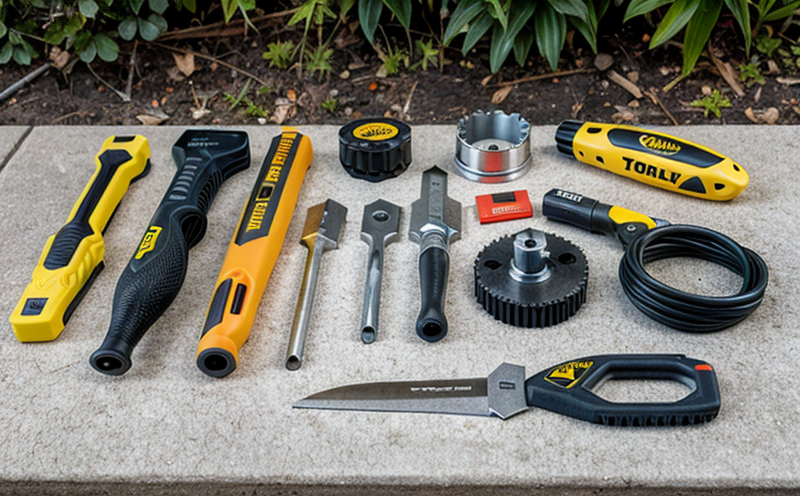Consumer Usability Testing of Power Tools
In today’s fast-paced world, consumer usability testing is essential to ensure that power tools meet not only safety standards but also the expectations of end-users. This service focuses on evaluating the ergonomics, ease-of-use, and overall user experience of various power tools such as drills, saws, routers, and sanders. Our comprehensive tests are designed to identify potential issues early in the development process, ensuring that products not only meet regulatory requirements but also provide a safe and efficient user experience.
Consumer usability testing goes beyond simple functionality checks; it encompasses an array of factors including handle design, tool weight distribution, trigger sensitivity, noise levels, vibration control, and overall comfort. By incorporating real-world usage scenarios into our tests, we can identify areas for improvement that might otherwise go unnoticed in laboratory settings.
Our testing protocols are based on international standards like ISO 10856 (Power-driven hand tools - Ergonomic requirements) which provide a framework for assessing the ergonomic aspects of power tools. Additionally, we follow EN 387:2019 and ANSI S2.23-2014 to ensure that our evaluations are aligned with industry best practices.
During these tests, we simulate typical user interactions by employing a variety of methods including static testing under controlled conditions and dynamic testing involving real users performing tasks similar to those they would use the tool for at home or in professional settings. This approach allows us to gather insights into how different individuals interact with the product based on their physical attributes, skills, and preferences.
The results of our consumer usability tests provide valuable feedback that can be used throughout the design cycle—from initial concept development through final refinement stages—to make iterative improvements. The data collected helps manufacturers understand where they stand compared to competitors while pinpointing opportunities for innovation.
- Identify ergonomic flaws early in the product lifecycle
- Evaluate tool weight distribution and balance
- Determine trigger sensitivity levels that are comfortable yet responsive
- Analyze noise reduction measures to minimize operator fatigue
- Assess vibration control techniques for prolonged use comfort
Why Choose This Test
Selecting consumer usability testing as part of your product development process offers numerous benefits that can significantly enhance the marketability and safety profile of your power tool products. Firstly, it ensures compliance with relevant regulations such as those outlined in ISO 10856 and EN 387:2019, thereby reducing the risk of legal challenges or recalls due to non-compliance.
By participating in our consumer usability tests, companies gain access to actionable insights that can drive product improvements. These insights help manufacturers refine their designs based on actual user feedback rather than assumptions alone. This leads to more intuitive and safer products, which ultimately translates into customer satisfaction and loyalty.
The competitive edge gained from superior design is undeniable. Users prefer tools that are easy to handle and operate efficiently without compromising on performance. By investing in consumer usability testing early on, businesses position themselves favorably against competitors who may overlook important ergonomic considerations.
Furthermore, these tests offer an opportunity for continuous improvement across all stages of production. Feedback received from initial prototypes can be incorporated into subsequent versions, resulting in increasingly better-performing and user-friendly products over time. This ongoing optimization process not only maintains but also enhances the brand image associated with your company.
Competitive Advantage and Market Impact
- Elevated Brand Reputation: Demonstrating a commitment to quality through rigorous testing enhances consumer confidence, leading to increased brand loyalty.
- Informed Decision-Making: Accessing detailed reports helps manufacturers make informed decisions about design changes, potentially shortening time-to-market for new models.
- Differentiation from Competitors: Offering superior user experiences can differentiate your product in crowded markets, making it stand out to potential buyers.
The findings from our consumer usability tests provide actionable data that can inform strategic decisions regarding future product development projects. By leveraging this information effectively, businesses are better equipped to anticipate customer needs and preferences, fostering innovation within the industry.
Use Cases and Application Examples
Consumer usability testing plays a crucial role in various stages of power tool development. From initial concept brainstorming sessions where ergonomic principles are first considered, to detailed engineering phases aimed at fine-tuning specific features like grip patterns or trigger placement, our tests offer invaluable guidance.
One common scenario involves assessing how changes made during the design phase affect overall usability. For instance, modifying a tool’s weight balance could improve both ergonomics and operational efficiency. Our team would then evaluate these modifications using real-world scenarios to determine their impact on user experience.
Another frequent application is validating newly introduced features against existing market trends. Manufacturers often introduce new technologies or materials into power tools, but without thorough testing, there’s always uncertainty about how well they will be received by consumers. Through our tests, we help clients validate these innovations before full-scale production begins.
Finally, consumer usability testing also serves as a quality control measure towards the end of the product lifecycle. As tools age or new competitors enter the market, continuous evaluation ensures that existing products remain competitive and reliable.





